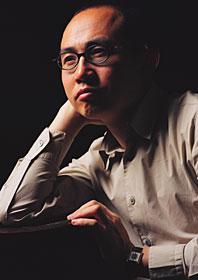Developer Pan Shiyi is bringing color to China's drab homes and offices
 |
|
TIMON WEHRLI/RED DOG STUDIO FOR TIME CROSSROADS: Pan's
projects are both good-looking and functional; and while he uses local
materials, the final buildings are global in flavor
|
When Pan Shiyi first articulated his vision of a modern Chinese home back in
the late 1990s, his backers balked. The Beijing real estate developer wanted
to paint the outside of his proposed apartment complex in bright primary colors.
No way, said his critics, China isn't colorful. The government recently underlined
that point by regulating that all public buildings should be painted gray. But
Pan, 39, who grew up in blighted Gansu province (gray, gray and more gray),
was convinced that China's history didn't necessarily condemn its citizens to
a monochromatic life. After all, he remembered, the Xi'an terracotta warriors,
now a muddy shade of gray, were originally painted with such breathtaking colors
that some dyers were reputedly killed lest they give away the secret to the
brilliant tints. Only now, after centuries of being underground and later being
exposed to modern-day pollution, have they lost their luster.
So Pan and his wife Zhang Xin ignored the skeptics and built the daring Soho
New Town, a multihued complex of apartments and offices in eastern Beijing.
The designs showcase simple lines and big windows-minus the kitschy, Baroque
details like curlicued pillars and ornate bas-reliefs that crowd so many other
middle-class mainland apartments. To further cater to the Chinese market, Pan
added some features that are helpful but often absent when local architects
simply copy Western designs; for example, the kitchens are equipped with extra-strong
fans to suck up stir-fry smells. And there is the option to subdivide the flat
into many smaller rooms, so an apartment can fit the three generations that
often crowd into a Chinese home. "Even if Chinese don't know what they need,
we are pretty sure we know what they want," he says, sitting in his own airy
home in Soho New Town, which feels like a cross between Scandinavian modern
and Ming minimalism. "It isn't a style copied from the West but a style that
represents a whole new China." Indeed, Pan is tickled that his home defies easy
classification, that it doesn't fit neatly into either the Oriental or Occidental
category-just in the same way modern Beijing is a mishmash of cultural influences.
And, it seems, others appreciate the olio too. The sleek and colorful spaces
quickly paid off: in 2000, the units, which cost about $240,000 each, topped
Beijing's real estate industry in terms of sales revenue. Last
month Pan unveiled his latest project: a series of weekend villas
near the Great Wall. (The asking price for each Phase 2 villa: a cool half-million
dollars.) Designed by 12 Asia-based architects, the villas were built using
only Chinese materials. Persuading architects who were used to working with
the best Italian marble to rely exclusively on domestic products was tough.
But when they examined the quality of select Chinese materials, including a
smooth local granite and a sea-misty celadon, even the sniffy Japanese architects
were appeased. One designer created a house out of bamboo plywood Lego-like
blocks, while another cocooned bedrooms in a long, metallic tube. In a coup
for Asian architecture, models of the houses were showcased at this year's Venice
Biennale.
Last
month Pan unveiled his latest project: a series of weekend villas
near the Great Wall. (The asking price for each Phase 2 villa: a cool half-million
dollars.) Designed by 12 Asia-based architects, the villas were built using
only Chinese materials. Persuading architects who were used to working with
the best Italian marble to rely exclusively on domestic products was tough.
But when they examined the quality of select Chinese materials, including a
smooth local granite and a sea-misty celadon, even the sniffy Japanese architects
were appeased. One designer created a house out of bamboo plywood Lego-like
blocks, while another cocooned bedrooms in a long, metallic tube. In a coup
for Asian architecture, models of the houses were showcased at this year's Venice
Biennale.
Now Pan is working on another grand project: a 700,000-sq-m luxury apartment
complex that he hopes will redefine the heart of China's capital (even though
he may be slowed by the delay of a planned IPO of his company Soho China). Downtown
Beijing, Pan gripes, lacks architectural continuity, unless you count the dozens
of undistinguished buildings covered in tile and tinted blue glass. "Everyone
talks about how China has such a rich history," says Pan. "But I want to show
that the buildings we construct today can have a future too." Already he has
taken the novel step of noting the buildings near his site and adapting his
blueprints to create a sense of coherence in the city center. Other architects,
he says, have expressed an interest in doing the same, through similar colors
and themes. In the end, creating a mosaic of harmonious buildings may be Pan's
most important legacy of all.





